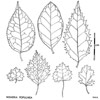Parent:
HOHERIA A. Cunn., 1839
1.
H. populnea A. Cunn. in Ann. nat. Hist. 3, 1839, 319.
|

|
Tree up to 10 m. tall or more; glab. or nearly so, except for stellate pubescence on young parts and infl. Branchlets slender, grooved, with pale bark. Juvenile plant similar in lf-form to adult or sts with branchlets very slender, divaricate, ± entangled; petioles very slender, up to 10 mm. long; lamina (5)-10-30 mm. long, broad-ovate to deltoid to suborbicular in outline, serrate, ± deeply lobed (teeth sts crenate). Lvs on reversion shoots similar. Adult plant with lvs on petioles up to c. 2 cm. long; lamina subcoriac. to submembr., (5)-7-14 × (3)-4-6 cm., broad-ovate to ovate-lanceolate to elliptic, acuminate (occ. lvs acute to obtuse or rounded), rounded to truncate to subcordate at base; deeply, coarsely, ± doubly, serrate-dentate. Fls c. 25 mm. diam., both solitary and in (2)-5-10-fld cymose clusters on same plant; pedicels c. 10 mm. long; calyx campanulate, ± 5 mm. long, teeth triangular; petals ± 10 mm. long, white; stigmas capitate. Mature carpels 5-(6), compressed, 5-7 × 5-7 mm. including broad wings.
DIST.: N. Coastal to lowland forests, especially marginal, from North Cape to c. lat. 38°.
FT. 4-7. FL. 3-4-(6).
Type locality: "Banks of rivers and skirts of forests on the shores of the Bay of Islands." Type: K, No. 600, R. Cunningham 1833.
A polymorphic sp. still unsatisfactorily delimited, owing to an incomplete knowledge of the range of forms and their distribution, and of the complications caused by heteroblasty, habitat-modifications and hybridism.

|
Fig. 14. HOHERIA POPULNEA. Leaves. Adult (above): Titirangi, T. Kirk, Poor Knights Is, W. R. B. Oliver, and more usual form. Juvenile (below) from Carse Herbarium.
|
|